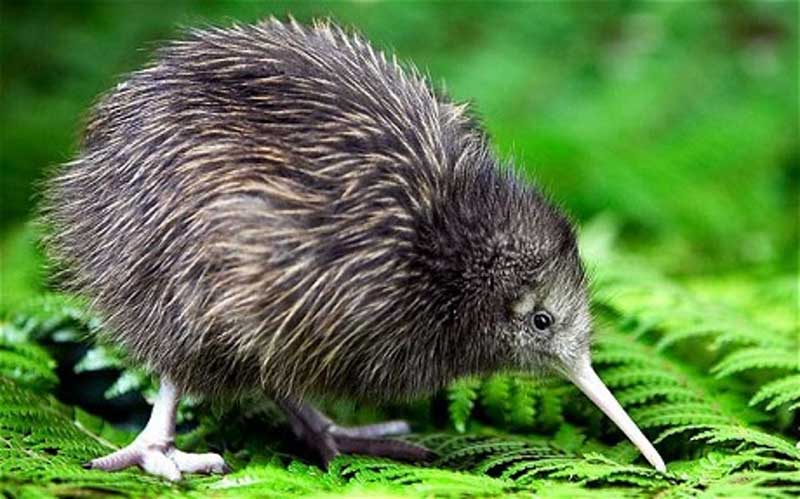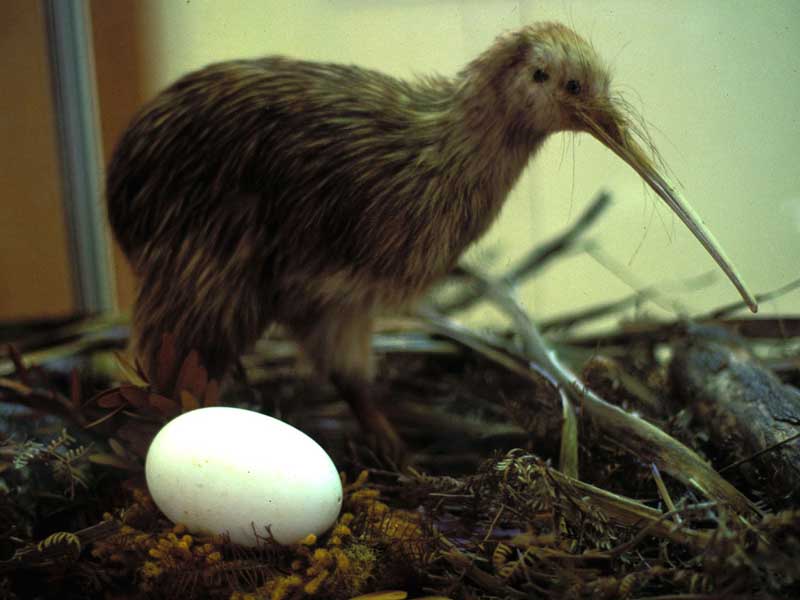
Before humans arrived in New Zealand about 1000 years ago, there were no land mammals that preyed on birds, and predators were only the preying birds, like the owls, eagles, falcons, and the likes. With no predators sniffing around, some of the birds found it easy to forage from the forest floor and save energy by walking alone as flying demands more energy.
In the course of evolution, birds like the Kiwi and others lost their ability to fly and became flightless. This may be a reason why New Zealand has more species of flightless birds than any other country in the world. However, whether kiwi evolved from a flightless ancestor or lost its ability to fly is debatable. It has small vestigial wings hidden under the bristly, hairlike, two-branched feathers, but like all the other ratites like the Ostrich, Emu, Rhea, and Cassowary, the kiwi has no keel, a special ridge on their sternum, where the flight muscles attach, since the ratites do not need keels as they do not fly. For many years it was thought that the closest relative of the kiwi was another ratite called moa, an extinct bird that was also native to New Zealand. But recent genetic studies have revealed that the kiwi is more closely related to Madagascar’s extinct elephant bird.

However, regardless of what it is related to, the odd-looking kiwi resembles a hairy pear, and its bushy coat helps it to camouflage in the woods to avoid the notice of the aerial preying birds.
Usually, most of the other adult birds have bones with hollow insides to minimize weight and make flight practicable, but the kiwis, approximately with the size of a domestic chicken, have marrow, like mammals and the young of other birds. They have wings, but the wings, equipped with cat-like claws on the tips, are only about an inch long and are useless for flying. They do not have a tail, but have very strong and muscular legs, which make up about a third of their body weight. They are equipped with four toes on each thick foot that help them to pad silently through the forest. However, their eyes are small, ineffective in full daylight and with a smaller visual field, the kiwis rely more heavily on their other senses.
They have large ears with a very good sense of hearing, and they have been seen tipping their head toward the source of a sound to hear it more clearly. The Kiwi is the only bird in the world that has nostrils at the end of its unusually long bills, rather than the base, along with sensory pits, which equipped the bird with a highly developed sense of smell.

The nocturnal kiwis sleep by day in burrows and forage for food by night. Apart from seeds and fruits, they also eat varieties of worms and insects, larvae, small crayfish, and amphibians. With their nostrils located at the end of their long beaks, the kiwis can locate the invertebrates lying under the ground without actually seeing or feeling them. The kiwis are very protective about their territories and patrol their areas every night, leaving smelly droppings to mark boundaries to keep away others, which is unlike a bird. If necessary, they shriek loudly, which is half scream and half whistle, to scare away the intruders, and in case of a fight, use its claws fiercely.

The kiwis are among those few species that tend to live as monogamous couples, and once they become a pair, they often mate for life which may last for up to 20 years. However, sometimes a female may choose a new mate if she finds a more desirable one wanders by. Unfortunately, like many other species, the male Kiwi neither has fancy feathers, nor has beautiful melodious calls to attract a female. He simply follows his desirable female constantly while grunting, and if she is not interested, the female might wander off or try to scare him away. During the mating season, June to March, the pair call out to each other at night and meet every three days in hollow logs or an underground nesting burrow dug by the male every three days. Usually, only one egg is laid per season, which is one of the largest eggs in proportion to the size of any bird in the world. The smooth and ivory or greenish-white kiwi eggs are huge in comparison to the size of the mother. While a human baby takes up only about 5% of its mother’s body, a kiwi egg weighing around 450 grams takes up around 20% of the female bird’s body. Producing the huge egg obviously creates significant physical as well as physiological stress on the female kiwi. The thirty days, which is required to fully develop the egg, the mother bird has to eat three times her normal amount of food to fulfill the demand of her body. But the last two to three days before the egg is laid, she is forced to fast due to the huge weight she is carrying in her belly. The large egg requires a long incubation period, and the male bird incubates the egg, which takes around 80 to 90 days. The chick hatches wearing shaggy adult feathers and its eyes open. It does not need to eat for about a week as it gets its nourishment from a large reserve of yolk in its abdomen. After gaining enough strength within a few days in the nest, the young kiwi leaves the burrow with the dad to learn about forage for food.

The Kiwi bird of New Zealand, which is said to earn its name from the sound of its cry, lends its name to the New Zealanders, apart from being the country's national bird and its unofficial emblem.